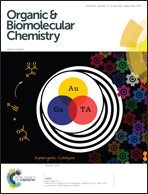Design, synthesis and biological evaluation of novel dimeric and tetrameric cRGD–paclitaxel conjugates for integrin-assisted drug delivery†
Abstract
Integrins are associated with tumour cell survival and progression, and their expression has been shown to be increased in tumours. Thus, four novel conjugates of the tripeptide integrin ligand Arg-Gly-Asp (RGD) and the cytotoxic agent paclitaxel (cRGD–PTX) were prepared to investigate the potential of the multivalent presentation of the RGD moiety in improving the antitumor efficacy of PTX by tumour targeting. PTX was conjugated to two or four integrin recognizing ligands. The influence of multivalent presentation on in vitro αvβ3-receptor affinity was confirmed. For all the conjugates compared to the previously synthesized monovalent counterparts, an enhancement of the binding strength was observed; this behaviour was more pronounced when considering the tetravalent presented RGD-conjugate. Cell growth inhibition assays on a panel of human tumour cell lines showed remarkable cytotoxic activity for all conjugates with IC50 values in a nanomolar range. Among the four conjugates, the bivalent derivative 3b was selected for in vivo studies in an ovarian carcinoma cell model xenografted in immunodeficient mice. A marked antitumor activity was observed, similar to that of PTX, but with a much more favourable toxicity profile. Overall, the novel cRGD–PTX conjugates disclosed here represent promising candidates for further advancement in the domain of targeted anti-tumour therapy.


 Please wait while we load your content...
Please wait while we load your content...